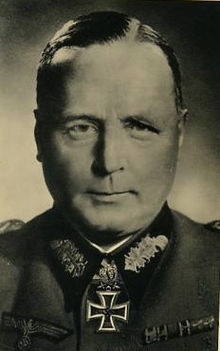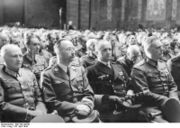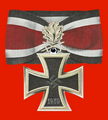Hans-Valentin Hube
| Hans Hube | |
|---|---|
| 29 October 1890 – 21 April 1944 (aged 53) | |
 General der Panzertruppen Hans-Valentin Hube |
|
| Nickname | The Man |
| Place of birth | Naumburg an der Saale |
| Place of death | near Obersalzberg |
| Resting place | Invalidenfriedhof Berlin |
| Allegiance | |
| Service/branch | Heer |
| Years of service | 1909 – 1944 |
| Rank | Generaloberst |
| Unit | Infantry Regiment Nr. 26 Fürst Leopold von Anhalt-Dessau |
| Commands held | 16th Infantry Division, 1st Panzer Army |
| Battles/wars | World War I World War II |
| Awards | Knight's Cross with Oak Leaves, Swords and Diamonds |
Hans-Valentin Hube (29 October 1890 – 21 April 1944) was a German general who served in the German Army during the First and Second World Wars. He died in an airplane crash in April 1944. Hube was nicknamed der Mensch ("The Man" or better "The human being") by his troops during the Second World War.
Contents |
Career
Pre-war period and World War I
Hube was born in Naumburg an der Saale in the Prussian Province of Saxony.
Hube joined the German Army on 27 February 1909, and after officer training, was assigned as a Fahnenjunker to Infantry Regiment Nr. 26 Fürst Leopold von Anhalt-Dessau, based at Magdeburg. With the outbreak of war in August 1914, Hube, now a platoon leader in the 26th, was sent to the front. He saw action during the early period of the war, being promoted to adjutant of the 26th's second battalion. On 20 September 1914, he was severely wounded at Fontenoy, Aisne, and as a result had his left arm amputated.
After a year convalescing, Hube returned to the front, this time as the 26th's 7.Company commander. By early 1918, he was acting as a standing General Staff officer with the 7th Infantry Division. On 10 April 1918, while commanding the defence against an English tank attack, Hube received severe gas poisoning. He spent the next year convalescing in hospital and saw the end of the war from his hospital bed.
Inter-War period
Upon his release from hospital, Hube was given a place in the Reichswehr. He continued his role as company commander in several Reichswehr regiments. In April 1925, he was promoted to Hauptmann and transferred to the Infanterieschule Dresden (Infantry School Dresden), to serve as an instructor to officer candidates. After he spent two years on training young officers, Hube was transferred to a general staff unit, and as a part of this posting was sent on a service trip to the USA. After his return from the US, Hube resumed his position as instructor at Dresden. In 1932, now a major, he was given command of IIIrd Battalion of the (East Prussian) Infantry Regiment 3. In 1933, after completing a heavy weapons training course in Döberitz, Hube was promoted to Oberstleutnant (Lieutenant Colonel) and placed in command of IIIrd Battalion of the Infantry Regiment 3 in Deutsch Eylau.
On 1 January 1935, Hube was transferred to the Infantry Training Staff at Döberitz. During this time he wrote the 2-volume manual Der Infanterist (The Infantryman). During this period, Hube was promoted to Oberst. On October 19, 1939, Hube was transferred to command the Infantry Regiment 3.
World War II
In September 1939, Hube's regiment saw action in Fall Weiss, the invasion of Poland. The regiment was then transferred west and took part in Fall Gelb, the invasion of France and the Low Countries.
On 1 June 1940, Hube was promoted to generalmajor and given command of 16th Infantry Division. In early August, the 16th was split into two divisions, one motorised infantry, one Panzer. Hube oversaw the formation of the 16.Panzer Division, and then led the division as a part of generalfeldmarschall Gerd von Rundstedt's Army Group South during Operation Barbarossa.
On 7 July, near Starokonstantinov, Hube's 16th halted an enemy counterattack. For this action, Hube got the Knight's Cross of the Iron Cross. On 16 January 1942, he was awarded the Oakleaves to the Knight's Cross for his actions near Nikolajew during the Battles around Kiev. Hube then led the 16th during Fall Blau, the attack to capture Stalingrad. The 16th Panzer Division was to form one of the armoured divisions to assault the city itself. In September 1942, Hube was given command of XIV Panzerkorps, the parent formation of the 16th Panzer. Hube commanded the XIVth during the disaster at Stalingrad. He was promoted to Generalleutnant and received the Swords to the Knight's Cross from Adolf Hitler personally on 21 December 1942. During his time at the Führer-Headquarters in Rastenburg, Hube argued strongly, but to no avail, for Hitler to allow 6th Army to attempt a breakout. Hube continued in command of the XIVth during the encirclement. On 18 January, Hitler ordered him to be flown out of the pocket. Despite his protests, Hube was flown out from the snow-covered Gumrak Airfield on the 19th in a Focke-Wulf 200C transport flown by the ace Leutnant Hans Gilbert. Hube was promoted to General der Panzertruppe.
After the destruction of Generalfeldmarschall Friedrich Paulus' Sixth Army, and with it the XIVth Panzerkorps, Hube was given the task of reforming the XIVth from scratch. After the completion of this task, Hube was sent to the Mediterranean front. In Sicily, he was charged with setting up its defence. He created Gruppe Hube, an army-sized formation whose task it was to defend the island. With the advent of Operation Husky on 10 July, Hube commanded the overall German defence. To make this task easier, on 17 July 1943 Hube was given command of all army and Flak troops on the island. Hube commanded the German forces' fighting retreat, and organised the evacuation to the Italian peninsula. Hube had prepared a strong defensive line, the 'Etna Line' around Messina, that would enable Germans to make a progressive retreat while evacuating large parts of his army to the mainland. Patton began his assault on the line at Troina, but it was a linchpin of the defense and stubbornly held. Despite three 'end run' amphibious landings the Germans managed to keep the bulk of their forces beyond reach of capture, and maintain their evacuation plans. Rescuing such a large number of troops from the threat of capture on Sicily represented a major success for the Axis. Hube was later involved in the battles defending Salerno from the Allied invasion.

Hube was moved back to Germany to take command of the Führer-Reserve OKH. On 23 October 1943, Hube was delegated as commander of the 200,000 man 1.Panzer Army, then serving with Army Group South under Generalfeldmarschall Erich von Manstein. In February 1944, Hube was officially confirmed as commander of 1.Panzer Army. Shortly after, III.Panzerkorps, one of Hube's units, was required to assist German forces breaking out of the Korsun-Cherkassy Pocket. Soon after this, Hube's entire force was trapped in a pocket near Kamenets-Podolsky. Hube and Manstein managed to extricate the formation and avoid disaster. The breakout lasted from 27 March 1944 until 15 April 1944, during which time Hube's forces destroyed 350 Russian tanks and 40 assault guns.

On 20 April 1944, Hube returned to Germany where Adolf Hitler personally awarded him the Diamonds to the Knight's Cross and promoted him to Generaloberst for his actions in Sicily, Salerno and in the Kamenets-Podolsky pocket. Hans-Valentin Hube was killed when the Heinkel He 111 which was shuttling him to Berlin crashed shortly after takeoff in Salzburg at Ainring on 21 April 1944. Only his black metal hand was recovered from the wreckage. He received a full state funeral.
Awards
- Iron Cross (1914) 2nd and 1st class
- Knight's Cross of the House Order of Hohenzollern with Swords
- Frederickscross
- Wound Badge (1918) in Black
- Cross of Honor
- Wehrmacht-Dienstauszeichnung 4th and 1st class
- Clas to the Iron Cross (1939) 2nd and 1st class
- Knight's Cross of the Iron Cross with Oak Leaves, Swords and Diamonds
- Knight's Cross on 1 August 1941 as Generalmajor and commander of the 16. Panzer-Division[1]
- 62nd Oak Leaves on 16 January 1942 as Generalmajor and commander of the 16. Panzer-Division[1]
- 22nd Swords on 21 December 1942 as Generalleutnant and commanding general of the XIV. Panzerkorps[1]
- 13th Diamonds on 20 April 1944 as General der Panzertruppe and commander in chief of the 1. Panzer-Armee[1]
- Eastern Front Medal
- Panzerkampfabzeichen in Gold
- Military Order of Savoy, Commander
- Mentioned in the Wehrmachtbericht on 17 August 1943, 31 January 1944 and 9 April 1944
References
- Citations
- Bibliography
- Berger, Florian (1999). Mit Eichenlaub und Schwertern. Die höchstdekorierten Soldaten des Zweiten Weltkrieges. Selbstverlag Florian Berger. ISBN 3-9501307-0-5.
- Fellgiebel, Walther-Peer (2000). Die Träger des Ritterkreuzes des Eisernen Kreuzes 1939-1945. Friedburg, Germany: Podzun-Pallas. ISBN 3-7909-0284-5.
- Fraschka, Günther (1994). Knights of the Reich. Atglen, Pennsylvania: Schiffer Military/Aviation History. ISBN 0-88740-580-0.
- McCarthy, Peter & Syron, Mike (2002). Panzerkrieg. New York: Carol and Graf Publishers. pp. 243-244
- Schaulen, Fritjof (2003). Eichenlaubträger 1940 - 1945 Zeitgeschichte in Farbe I Abraham - Huppertz (in German). Selent, Germany: Pour le Mérite. ISBN 3-932381-20-3.
- Scherzer, Veit (2007). Ritterkreuzträger 1939 - 1945 Die Inhaber des Ritterkreuzes des Eisernen Kreuzes 1939 von Heer, Luftwaffe, Kriegsmarine, Waffen-SS, Volkssturm sowie mit Deutschland verbündeter Streitkräfte nach den Unterlagen des Bundesarchives (in German). Jena, Germany: Scherzers Miltaer-Verlag. ISBN 978-3-938845-17-2.
- Williamson, Gordon (2006). Knight's Cross with Diamonds Recipients 1941-45. Osprey Publishing Ltd. ISBN 1-84176-644-5.
- Helden der Wehrmacht - Unsterbliche deutsche Soldaten (in German). München, Germany: FZ-Verlag GmbH, 2004. ISBN 3-924309-53-1.
External links
- Hans-Valentin Hube Lexikon-der-Wehrmacht German Language site.
| Military offices | ||
|---|---|---|
| Preceded by Generalleutnant Heinrich Krampf |
Commander of 16. Infanterie-Division 1 June 1940 – 1 November 1940 |
Succeeded by General der Infanterie Friedrich-Wilhelm von Chappuis |
| Preceded by Generaloberst Eberhard von Mackensen |
Commander of 1. Panzerarmee 29 October 1943 – 21 April 1944 |
Succeeded by Generaloberst Erhard Raus |
|
||||||||||||||||||||
|
|||||||||||
|
||||||||||||||||
|
||||||||||||||||||||||||||||||||||
